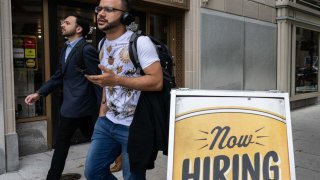
- The unemployment rate rose to 4% last month for the first time since January 2022.
- While economists say they aren't worried, they are keeping an eye on unemployment insurance claims and any news of layoffs that could indicate a recession.
- New college graduates and people seeking entry-level jobs might have more trouble finding a job as the number of people aged 20 to 24 entering the workforce jumped in May.
The unemployment rate, which has remained low for two years, has been inching higher in the first half of the year, according to data from the Bureau of Labor Statistics.
For the first time since January 2022, the unemployment rate ticked to 4.0% last month, up from 3.9% in April. It was as low as 3.4% in April 2023.
Even though the employment rate has reached the highest it has been in a couple of years, 4% is still historically low, experts point out.
Get Connecticut local news, weather forecasts and entertainment stories to your inbox. Sign up for NBC Connecticut newsletters.
Economists say people shouldn't be too concerned because both the number of jobs and the size of the labor force are growing. And while the year kicked off with layoffs from big names such as Google and Amazon, the trend hasn't caught on in the broader labor market, experts said.
May's unemployment rate was impacted heavily by people, particularly those who are between 20 and 24 years old, entering and reentering the workforce, according to Moody's Analytics head labor economist Marisa DiNatale.
With school out for the summer, it's typical to see a boost in teenagers, college students and recent graduates beginning their job search.
Money Report
"It's a very volatile age group," DiNatale said. "People are finding it more difficult to find a job when they graduate from college, but there is no evidence that there are some sort of massive layoffs going on in the economy."
Payrolls soar, 'no real indicator for a recession'
Meanwhile, another factor boosting confidence for economists is job growth. Nonfarm payrolls grew by 272,000 in May, BLS data shows, outperforming the Dow Jones consensus estimate of 190,000.
In addition to workforce and payroll growth, a high labor force participation among prime-age workers is reassuring, according to Stephen Juneau, U.S. economist at Bank of America. The percentage of people between 25 and 54 participating in the workforce is 83.6%. That's the highest it has been in at least 20 years according to BLS data.
"When you look at the aggregate labor market data, there's no real indicator for a recession," Juneau said.
While economists say they aren't concerned about a 4% unemployment rate on its own, they are paying attention to how fast the rate is rising.
One way to measure this is through the "Sahm Rule," named after economist Claudia Sahm.
The rule compares the average unemployment rate for the past three months with the lowest reported rate in the past year. If the three-month average is half a percentage point higher than the yearly low, then the unemployment rate is rising fast enough to signal the start of a recession.
Following the May jobs report, the Sahm Rule stood at 0.37. This means the unemployment rate would have to stay at 4% or higher for the next couple of reports to bring the three-month average 0.5% above the yearly low, which in this case is 3.5%.
"The Sahm Rule is a contemporary indicator that we're in a recession," Juneau said, "We're not worried it's going to cross that 0.5% next month."
When to worry
Moody's DiNatale said she is keeping an eye on unemployment insurance claims, which are historically low. For the week ending June 15, the BLS reported that 238,000 Americans applied for unemployment benefits.
"If they go near or above 260,000, then it's usually time to worry. We're nowhere near that," DiNatale said. "What would be more worrying is if employers were actually laying people off. We're looking for big, sharp movements."
As for the number of jobs added in future reports, Juneau said he wouldn't be concerned unless it dropped below 100,000.
"Outright job losses, they can kind of come out of nowhere and the labor market tends to snowball," Juneau said. "We don't expect that in the next labor report, but there's always that risk."






